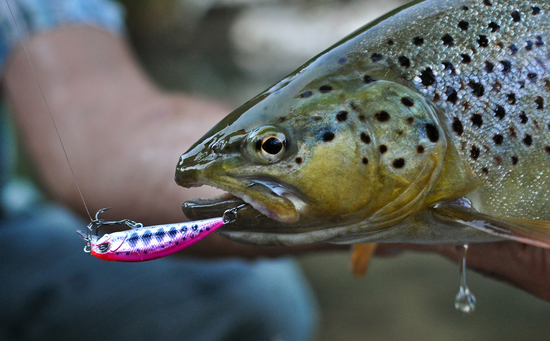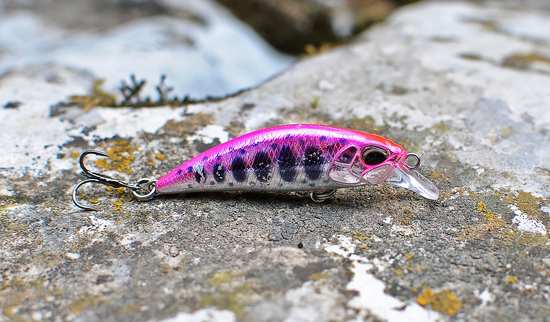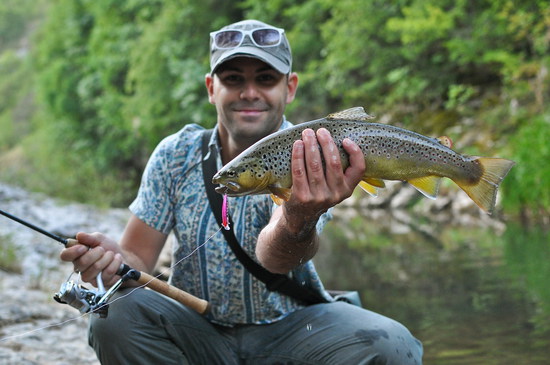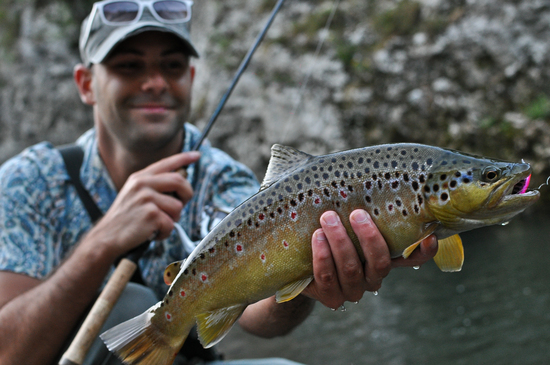Think Pink – ENG
The four elements
Color is one of four primary triggers for attacks on lures; the other three are shape, size and behaviour of prey. To understand how the colors “work” we must first know what color really is and the way the human eye, thus the eye of trout perceives it.
Each object contains a chemical substance that attracts the most light of particular wavelength and reflects a specific color that is recognized by the eye. By combining three basic colors: red, green and blue, we produce complete images of colors and their many variations. Human eye possesses three different types of membranes. Each membrane has the ability to absorb sunlight rays of specific wavelength (color), from red to purple-blue. Differing from the human eye, trout’s eye contains four types of membranes that are sensitive to sun rays of longer/shorter wavelengths. As a consequence of greater photosensitivity, trout are able to determine infrared and ultraviolet color variations that remain invisible to the human eye. Trout are most efficient in determining differences in shades of blue, then red and in the end green. However, although trout possess a wider range of color recognition, their vision is strongly influenced by habitat. Trout color recognition ability is further limited by following factors: water clarity, depth and fish’s distance from it’s pray.
Water is a crucial limiting factor for color recognition. Aquatic environment directly influences transmission of certain colors (penetration/reflection of sunlight and its wavelengths). Underwater, color can only be recognized if a specific wavelength of sunlight is present, penetrating water surface and reflecting itself on an object. Sun rays of longer wavelengths (red) fade at approximately 3, 5 meters of depth in clear water, while rays of shorter wavelengths (blue) disperse on water molecules and penetrate deeper. In aquatic environment, bottom or water itself present a background image for lures. When we observe clear water horizontally, background appears in shades of blue or green. This phenomenon known as back-light area is created by blue light of short wavelengths dispersing on water molecules. The color (or shade) of back-light area depends on water content. Therefore, waters containing higher quantities of phytoplankton will appear green. In conditions of lesser light penetration, larger depths or bigger distances all colors become shades of gray, while white remains unchanged. Fluorescent shades amplify color intensity. Strong contrasts of fluorescent colors like pink, orange, red and chartreuse are easily distinguished in any degree of water clarity. However, in certain conditions fluorescent color of our lures is not sufficient. Reflection off metallic surface will be visible further than color and will reflect light further, and this is why we should always have a lure with silver or gold surface/laser finish in the lure box. This lure pattern will attract much more attention in conditions of low visibility or reduced light penetration than neutral color, transparent or matted surface lures.
Beside correct choice of lure color, we must have a lure of virtuous attributes. DUO was able to integrate all of these elements in one excellent little lure designed for trout fishing. Spearhead Ryuki 45S in metallic-pink pattern is a sinking twitch wobbler, an ideal protagonist for this story. In several fishing sessions I was able to catch a couple or more fish in different light conditions and water clarities. I had most success at dawn and dusk in clear water conditions. Perquisite for good angling were sun rays of longer wavelengths (red) that penetrated the water deeper at a lower angle and therefore, in my case, intensifying the pink color of my lure. Different from morning and evening light conditions, period around noon when sun rays of shorter wavelengths (blue) penetrate the water deeper was a time when the intensity of pink wasn’t overstressed, but metallic surface of my lure came to power reflecting sun rays. On the other hand, in conditions of slightly muddy water I had better results in shallow areas of the river. The reason for this was limited light penetration due to water being slightly murky. At a certain depth where sun rays of longer wavelengths where present, pink pattern was “screaming” through the water making a strong contrast in the environment and infuriating trout. In some parts of the river with greater depths, like deep whirlpools, I was able to get trout’s attention only by retrieving the lure on the surface or in middle depth areas where the lure could receive more light and emit its intensive color.
Having in mind that DUO Ryuki Spearhead 45S with its 4 grams in weight is a strictly sinking twitch bait, it must be properly presented in adequate locations. Some typical locations include deep whirlpools, narrow sections with stronger current, holes or sharp drop-offs on the bottom, rapids, etc. Simply speaking, wherever floating and suspending models are off limits due to difficult water conditions, use of heavier lures is an effective solution. Because of its weight, Spearhead is inadequate for steady slow retrieves except in strong currents. This little guy isn’t designed for boring retrieves; it’s made for “burning”!
Fast retrieve of pink bait in the shallows will trigger reaction strikes, aggressive and instinctive attacks on our lure. Always have in mind that it’s impossible to retrieve our lure too fast for the agile trout!
In deep whirlpools we can use a couple different retrieves with the pink Spearhead. Classic jigging in combination with ripping is an excellent method for large trout. Only flaw of this presentation are snags and possible loss of lures because we let the bait sink to the bottom. Once the bait is on the bottom, we use sharp and continuous movement from the elbow to straighten the rod tip and raise the bait (half a meter up to one meter) from the bottom and then let it sink again. To reduce the risk of losing our bait we choose a bottom made of bulky gravel or marble.
 Constant twitching with occasional changes of pace is a standard and most productive method for majority of trout and is applicable for both deep and shallow areas. This technique consists of a series of rapid and constant twitches with very short pauses. To explain this method in greater detail, I will use numbers and periods with numbers representing twitch movements and periods representing half second pauses. Envision the following: you put your index finger on the line, open the bail, make a diagonal upstream cast next to a rock, let the bait sink to the bottom, close the bail, start reeling, put the rod tip down and start twitching; 1.2.3.123.1.2.3.123.1.2.3. For any questions regarding this technique, as well as many other methods, contact me at darkopeshic@gmail.com, I will be happy to help you.
Constant twitching with occasional changes of pace is a standard and most productive method for majority of trout and is applicable for both deep and shallow areas. This technique consists of a series of rapid and constant twitches with very short pauses. To explain this method in greater detail, I will use numbers and periods with numbers representing twitch movements and periods representing half second pauses. Envision the following: you put your index finger on the line, open the bail, make a diagonal upstream cast next to a rock, let the bait sink to the bottom, close the bail, start reeling, put the rod tip down and start twitching; 1.2.3.123.1.2.3.123.1.2.3. For any questions regarding this technique, as well as many other methods, contact me at darkopeshic@gmail.com, I will be happy to help you.
Twitch jigging is a method that got me the biggest trout using “Pinky” Spearhead. This presentation consists of raising the bait from bottom to surface. In order to successfully perform this method we must find a deeper section of the river and position ourselves so we can lower the bait almost vertically to the bottom and retrieve it using the same trajectory. When the lure reaches the bottom we use a combination of twitching and reeling to raise it up slower or faster, depending on the speed of presentation.
You will be surprised of all the things that will raise up to grab your bait!
Text: Darko Pesic
Tekst na srpskom, pročitajte u magazinu “Spin & Fly”, br 19.
- Abundance of slimy fish
- Avid protiv Golijata
- Brancin – vladar obalnog mora
- Brancini peščanog spruda
- Bucov – Jutarnji mega cugovi
- Bucov pre mresta
- Duga na površini
- Džig i njegove prednosti
- Fail Fishing Team sea report 2
- Fish ID – Vječna dilema
- Francuski salmonidni safari
- Godišnji servis mašinice
- Ito Vision OneTen (110)
- Jerkovi
- LAV MD Trgec – Teški metal, naš a svetski!
- Lov smuđa na sunđeraste peševe
- Mega test – Orka Kosač (drugi deo)
- Mega test – Orka Kosač (prvi deo)
- Mikrodžigovi – Zimski meni
- Ne manjka slinavih riba
- Od ideje do uspeha – Oni vraćaju mladicu Drini
- Orka Fenix
- Orka Oskar – Magija umirućeg šeda
- Osmatranje vode i terena
- Osnove lova džerkovima
- Pastrmka u proleće
- Penn Slammer – pouzdan i jak!
- Peševi koji to nisu
- Preklopni mehanizam mašinice
- Putopis sa Baltika
- Rapala Flat Rap – Ravno na vrh
- Revir Zmajevac na Sani
- Ribolov iz kajaka
- Sedam sistema za lov basa
- Smuđ kamenjar – mali, agilni šmeker
- Somovi
- Sova (buljina), mojim očima
- Spinerbait
- Sportex Black Pearl
- Sportex TiBoron na maraton testu
- Štap po meri ribolovca
- Stick bait opsesija
- Test: Okuma Celilo Spin
- Think Pink
- Think Pink – ENG
- Uhvati i pusti
- Uhvati, slikaj, pusti i okači preparat na zid
- Ultralight na moru
- Upredene strune – od A do Š!
- Varaličarenje pastrmke nimfama
- Varaličarenje strajpera
- Varaličarenje štuke tokom zime
- Varaličarenje zubatice – Bluefish u New Yorku
- Varalicom na klena
- Weedless montaže
- Zimsko varaličarenje klena na malim rekama
- Zračna opasnost
- Joj što volem buku ja!
- Žuti grgeč
- Dragi, a nezvani gosti
- Dan na jezeru Iri
- Teorija male varalice
- Vobler po meri štuke
- Una, jedna jedina











